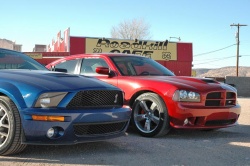 Shelby GT500 and Charger SRT8 at the Roadkill Café. Click image to enlarge |
| Dash for Nash, Part one Dash for Nash, Part two Related reading |
Originally published on January 3, 2007 as Part 3 of the Dash for Nash Road Trip Series
Article and photos by Paul Williams
Photo Gallery:
Dash for Nash
If there’s any song that Bobby Troup will be remembered for, it’s the perfectly conceived, “(Get your kicks on) Route 66.” Apparently, the melody came to him almost as a finished piece, while driving from Pennsylvania to Los Angeles in 1946, where he was hoping to land a job playing jazz music in one of LA’s nightspots. He wrote the lyrics based on some of the towns and cities he encountered along the way. It was Nat King Cole who scored a big hit with the song, but you can still find Bobby Troup’s stripped down, nightclub version if you search a little.
It winds from Chicago to LA,
More than two thousand miles all the way.
Get your kicks on Route 66.
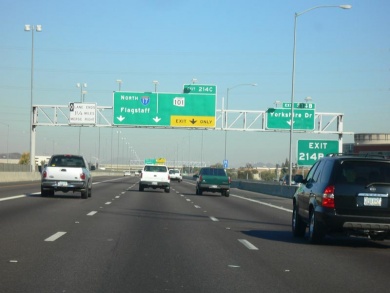 It’s almost all trucks on I-17 in Arizona. Click image to enlarge |
With our mission to see Steve Nash and the Phoenix Suns play the Toronto Raptors in Phoenix accomplished (See Dash for Nash Part 1 and Part 2), colleague Michael Bettencourt and I were left with two fast cars, a 2007 Ford Shelby GT500 Convertible and a 2006 Dodge Charger SRT8, and a choice of routes back to Los Angeles. The most direct option was the interstate highway, the way we came. But Michael had the excellent idea of traveling along part of the old Route 66, which is north of Phoenix, and features some of the great motels, gas stations, and eateries from the 1950s, or what’s left of them. Now largely a tourist attraction for the nostalgic, Route 66 still has mystique, and as I say, we were in possession of two fast cars, both iconic nameplates of the muscle car era, and had a bit of time to play with (one day, actually, as our flight back to Toronto/Ottawa was scheduled to leave at 7:00 AM, the next morning).
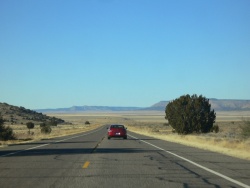 Making time on the Historic Route 66. Click image to enlarge |
Now you go through Saint Looey
Joplin, Missouri,
And Oklahoma City is mighty pretty.
You see Amarillo,
Gallup, New Mexico,
Flagstaff, Arizona.
Don’t forget Winona,
Kingman, Barstow, San Bernardino.
When you think about it, between the Shelby GT500 and the Dodge Charger SRT8, we had a rather gross total of 925 horsepower at our disposal. So, granted, this was more of an exercise in indulgence than restraint. We also had a significant number of decibels emanating from our combined quad exhausts, and the two vehicles driven in tandem were making quite an impression wherever we went. After refueling yet again (I’ll get back to that), we took I-17 north towards Sedona and Flagstaff, detoured along Route 69 to Prescot, then took Route 89 to Ash Fork, and headed west on the I-40 for 30 km before leaving it for the old Route 66.
As you may know, it was the establishment of the U.S. Interstate highway system in the 1950s that spelled the demise of Route 66 and similar roads, and the towns and businesses supported by them. But we didn’t expect to see shiny diners and friendly “at your service” gas stations from yesteryear; we just wanted to get our tires on that tarmac, for the experience of it.
 The Rusty Bolt, in Seligman, Arizona. Click image to enlarge |
Leaving I-40 at Seligman, and joining the “Mother Road,” as John Steinbeck called it, our Route 66 experience would take us through Valentine, Peach Springs, Hackberry, and return to the I-40 at Kingman. From there we’d take I-40 to Barstow, and I-15 to San Bernardino and Los Angeles.
A friendly State Trooper at Ash Fork gave us directions and, eyeing the fast wheels, cautioned us not to “get criminal.” Only that morning, he said, he’d stopped someone going 100 mph.
Which we took to mean that staying below “the ton” would be prudent on his patch.
Truth be told, this was turning out to be a long drive. Looking at the map over breakfast (the Grand Canyon Special for me; the All American for Michael) at what turned out to be the excellent Wyndham Hotel in Phoenix, our route seemed a reasonable distance to Los Angeles. But the reality is that like Canada, the U.S. is a huge place. What seems a short hop on a map can surprise you, especially when you need to stop at attractions like the Roadkill Café and The Rusty Bolt Gift Shop and Museum. Phoenix to Seligman was 300 km just to get to Route 66, which itself added another 160 km. The drive from Kingman, through Barstow to Los Angeles Airport added 550 km for a total of 1,010 km. We belatedly figured this out in Ash Fork, in the early afternoon, and pressed on with more urgency.
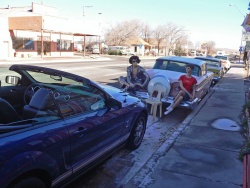 Seligman, Arizona. Click image to enlarge |
But a long haul like this really brought into relief the similarities and differences between our modern muscle cars. We certainly weren’t complaining. What else would we rather be doing?
In the U.S.A., these cars are priced similarly, with a loaded 2006 SRT8 available at $42,885 (base $35,320), and the GT500 costing $40,930/$45,755 for the coupe/convertible (all prices include delivery charges). In Canada, the pricing is not quite as comparable, with a similarly equipped Charger costing $50,940 (base $44,370), and the 2007 GT500 coupe listed at $52,299, and convertible at $57,749.
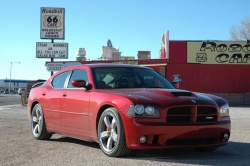 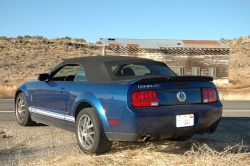 Seligman, Arizona. Click image to enlarge |
Both cars, of course, are rear-wheel drive, and feature fashionably big wheels and very powerful brakes. But the Charger platform is more sophisticated than the Shelby GT500′s. The Charger has traction control and vehicle stability control, along with a multi-link rear suspension (the platform for this car features components derived from Mercedes-Benz). Tires are huge 245/45-20 Goodyear Eagle RS-As, front and rear. Put your foot down hard in this car and it launches straight, the transmission shifting crisply at the 6,400 rpm redline, the power from the 6.1-litre Hemi V8 pushing you back hard into the seat as the car shoots forward. The steering assist is firmly weighted, and you feel like you’re always in control, despite the SRT8′s performance potential.
The Shelby GT500 also has traction control, but no stability control. There is, however, a limited slip differential to help manage its supercharged 500 hp and 480 lb-ft of torque. It features a McPherson strut front suspension and three-link rear suspension tied to a solid rear axle, and wears wide 285/40-18 Goodyear Eagle F1 tires at the rear (front tires are 255/45-18) that also help to put the power down. Floor the accelerator and release the clutch in this vehicle, and it hurtles forward like one of those rocket-powered railcars that scientists used in the 1950s to test how much acceleration human beings could actually take. There are slightly faster cars off the line (not many), but the sheer, visceral force of the GT500 as it leaps to life, its supercharger wailing, its engine almost instantly spinning up to 6,250 rpm, has to be experienced. It’s completely different than the Charger in this respect. It is sudden, physical and raucous (and that’s not to suggest the Charger SRT8 can’t get a move on when asked; it just does it differently).
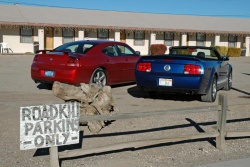 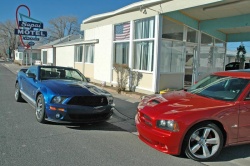 Seligman, Arizona. Click image to enlarge |
Add to this the fact that the manual transmission in the GT500 is more NASCAR beef than Formula1 paté, and you have a real handful off the line if you’re not careful. Ford’s 0–60 mph (0–96 km/h) times are 4.3 seconds for the GT500, and Dodge reports 5.0 seconds for the Charger SRT8 (although most reviews suggest that’s a somewhat optimistic number for the GT500).
Once underway, these driving impressions continue. While the Charger feels almost unflappable on all road surfaces, the GT500′s less advanced suspension can upset the car—especially at speed on rough or undulating roads—and create a somewhat bouncy experience for the driver. The steering is lighter than I’d prefer, which may contribute to the car’s occasional tendency to wander, and the super-wide tires can pull the unwary driver off course.
Don’t get me wrong. On a smooth road, the GT500 typically feels calm at speed. But it would be much easier to lose than the Charger SRT8 in the hands of an inexperienced driver, and conversely, it requires a good driver to get the best out of it.
The GT500 is also comparatively heavy and, surprisingly, doesn’t feel as nimble as the Charger SRT8. With a length of 4765 millimeters (187.6 inches), it weighs in at 1840 kilograms (4040 pounds). The Charger SRT8 is a considerably bigger car with a length of 5082 mm (200.1 inches), but weighs in only slightly more at 1887 kg (4160 lbs), and it feels better balanced.
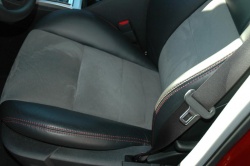 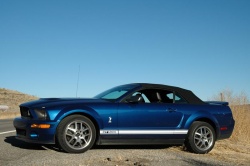 Charger seat (top) and Shelby GT500. Click image to enlarge |
Inside, the Charger SRT8 features tasteful leather seats with suede inserts. Red stitching contrasts nicely with the grey leather, and the seats have power lumbar support. Additionally, a button on the side of the seat adjusts the pedals. The white-faced instrument cluster adds a sporty touch, and remote controls on the tilt/telescoping steering wheel manage the audio, cruise and trip computer functions. As equipped, our car included a navigation system, upgraded audio, sunroof, heated seats, dual zone climate control, and “UConnect” hands-free communication system, among other creature comforts.
Outside, the 20-inch wheels are impressive, as are the shiny red-painted Brembo brake calipers behind them. Under the hood, the engine bay is finished with an aluminum plenum chamber and custom graphics. The hood is supported by two gas lifts, causing it to hiss seductively as it opens and closes. Overall, you get the impression that the Charger SRT8 was the focus of attentive engineers and designers adding flourishes here and there to set it apart—to make it special. That being said, the Charger SRT8 is something of a sleeper, and doesn’t much broadcast its performance potential beyond the base Charger’s already formidable and chunky appearance.
The Shelby GT500 wears smaller 18-inch wheels (if 18-inches can be considered small), but on this car, they kind of look it. The standard matte black brake callipers, although they are also Brembo, do nothing for the look of the car in profile. The interior is very plain: black leather seats, black door panels, black dashboard. It’s basic black, in other words, with some spare silver trim. The steering column tilts, but doesn’t telescope, and as far as the seats go, it’s no heat or lumbar support for you.
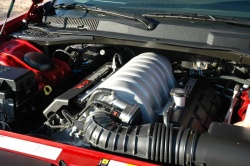 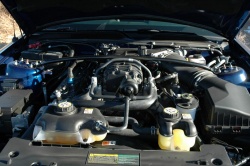 Charger (top) and Shelby. Click image to enlarge |
The instruments are not illuminated in daylight, which makes them hard to read, and cast a garish purple glow at night (clashing with the green illumination for the controls on the centre stack). I know that a user-selectable option is available for Mustangs, so you can change the colour of the instrument illumination. But if this was fitted to our GT500, I couldn’t find it, and had to endure the purple haze.
The engine bay is also something of a disappointment. The supercharger sits on top, but it’s not specially finished. Valve covers say “Powered by SVT” but they’re hard to see (in fact, the name of this car is something of a mystery; I’ve seen it described as a Ford Shelby Cobra GT500 SVT, although “Cobra” is not an official name for this car). Wires and components seem to be located where space is available, rather than being part of an overall engine bay design. A single prop, like that of an old British sports car, supports the hood.
However, what it loses in interior and exterior embellishments, the GT500 makes up for in overall shape and presence. The front fascia is spare, dark and menacing; the heat extractors on the bulging hood look like nostrils that might belch flame in vehicles of another era; the GT500 stripe down the side is like a billboard advertising its horsepower (in case you didn’t already know), and the rear fascia kind of leans forward, giving the impression that the car is flipping the bird as it blows by. It’s an arrogant, pushy, self-important vehicle, and if you don’t like it, it seems to say, “well, too damned bad!”
There aren’t many cars next to which a red Dodge Charger SRT8 would be called subtle, but the Shelby GT500 is one of them.
Choosing between them for a cross-country trip would be an interesting exercise. The Charger SRT8 definitely suits the long cruise. It’s got room, it’s comfortable, it’s got power to spare, it has presence, and it’s a bit cheaper than the Shelby to operate (although the 6.1L version of the Hemi doesn’t feature cylinder deactivation, like the 5.7L in standard trim). The Charger also handles much better than you’d think a big car would. Even on a racetrack, you can throw a Charger SRT8 around corners with confidence; on public roads, it’s just fine. Passing, obviously, is not a problem.
The Shelby GT500, in contrast, is a more challenging car. It’s not as comfortable as the Charger, and is more tiring—meaning more work—on a long drive. In stop and go traffic with its heavy clutch, the GT500 is a bear. You really don’t want to get stuck in slow traffic for a couple of hours like I did, as both you and the car will find your temperatures rising. An automatic transmission would help (it’s not available), but then you’d lose the thrill of dropping the clutch in first, and banging the Tremec racing gearbox into second, third, and fourth when the traffic clears (fifth and sixth are largely cruising gears). You’d also miss that glorious engine shamelessly announcing its presence, especially when you’re driving with the convertible top down. Satellite radio notwithstanding, that’s all the music you really need in a GT500.
On the open road, however, the firm suspension of the GT500 can be distracting at times, especially when the pavement is broken and the car bump steers you into a state of heightened awareness. Woah, Nelly—two hands on the wheel at all times in this car. Basically, the Shelby GT500 accelerates, steers, rides and brakes like what it is: a muscle car. The heaviness of the vehicle and the lightness of the steering seem somewhat out of synch’ to me, and it feels characteristically rough around the edges. If you want a more civilized ride, and you like the GT500 looks, get yourself a V6 Mustang, I guess, and put stripes on it. The GT500 is what it is.
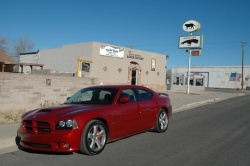 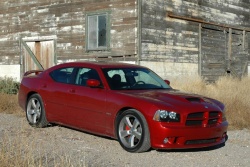 Dodge Charger SRT8. Click image to enlarge |
Fuel consumption has to be mentioned, because it became something of an issue on our drive from Kingman to Barstow. The Shelby GT500 has a small, 60 L tank, compared with the 70 L tank fitted to the Charger SRT8. Furthermore, the GT500 returned 14.0L/100km on our trip, and the Charger SRT8 managed 12.2L/100km. So, the Charger uses less fuel and has a bigger tank, giving it a much longer range on one tank. We were continually filling up the GT500, and ended up at one point trying to conserve fuel in it by drafting behind the Charger SRT8 at 90 km/h, with the GT500′s on-board computer predicting 35 km left to empty. Not amusing, especially when we were in the middle of nowhere, at night, and the navigation system in the Charger showed the closest gas station 100 km away!
Fortunately, it was wrong (although, so much for the nav system…). We found a gas station 20 km down the highway (at Ragtown, which wasn’t on my hand-held Garmin navigation device either). But the fact is, there’s hardly any range in the GT500, and it was a noticeable deficiency compared with the Charger SRT8.
It turned out that the Route 66 portion of our drive was well maintained, and virtually devoid of traffic. We did get to visit the Rusty Bolt, and managed a photo shoot at the Roadkill Café in the late afternoon. We also saw some of the celebrated old garages and motels, the neon lights from their cheerful fifties’ signs having flickered out long ago. At one point on the open road, we ran neck-and-neck with a Burlington North Santa-Fe freight train (where the track was only metres away from the road), our headlights jointly illuminating the way, as the sun set ahead.
It was worth the drive.
Which brings us to the final observation about our cars, and this may be what it all boils down to. The original Shelby GT500 and its siblings from the late 1960s, like the GT350 and Hertz Mustang, along with the other Mustang variants, are special vehicles. They’re imprinted in North American cultural consciousness. Young people know of them, older people remember them and lovingly restore them; and for many people they have great meaning and desirability. Even though a Mustang and a Charger were featured in the movie, Bullitt, let’s face it: Steve McQueen was driving the Mustang.
If you’re going to do a cross-country trip, driving an updated version of the Shelby GT500 gets you lots of attention at the gas stations, diners, and motels you’ll visit along the way, and attracts thumbs-up and wistful looks from just about everybody you meet. Many people stop and stare, one person we met thought our GT500 was a restored vehicle from 1969. He sighed audibly.
So in my view, if you were going to explore US highways and byways, you’d want to be in a Shelby GT500, preferably a convertible.
But (there’s always a but) I believe the new Dodge Charger SRT8 is a valid modern interpretation of its 70s’ namesake. Granted, it’s not a coupe, not a convertible, but as an everyday hot rod for the 21st Century, it’s an intriguing and compelling package. Conclusion? Charger SRT8 for the week; Shelby GT500 for the weekend.
But either way, as Bobby Troup suggested when concluding his famous song:
Won’t you get hip to this timely tip:
When you make that California trip,
Get your kicks on Route 66.
(“Route 66”: written by Bobby Troup, available on CD.)
More information on Route 66: Route 66 on Wikipedia; Historic66.com.
Read the first two instalments of “The Dash for Nash:” Part 1 and Part 2.









